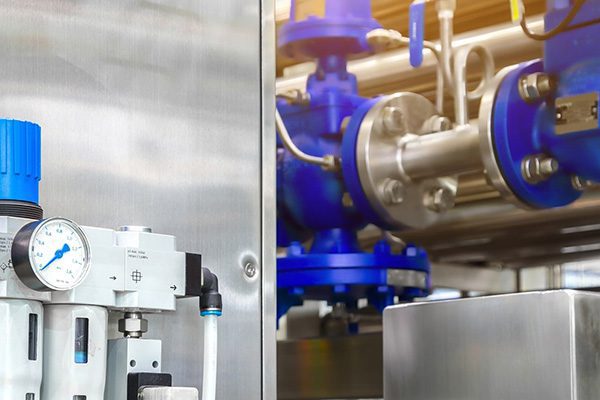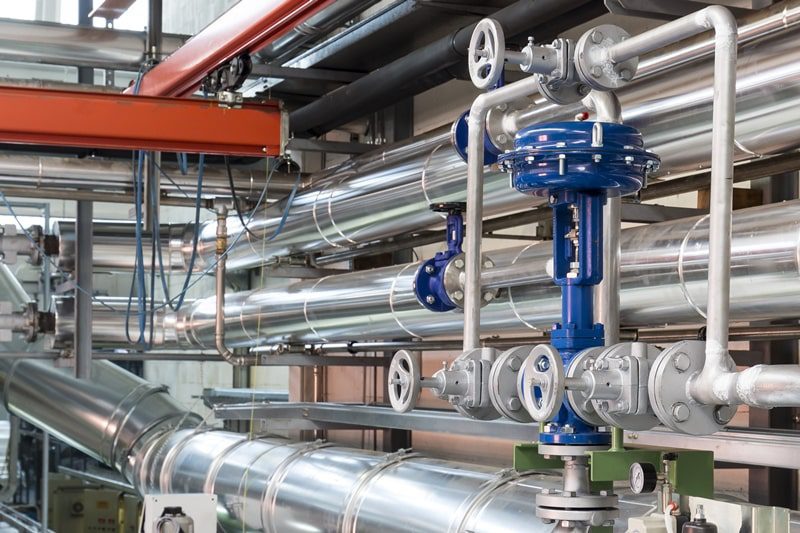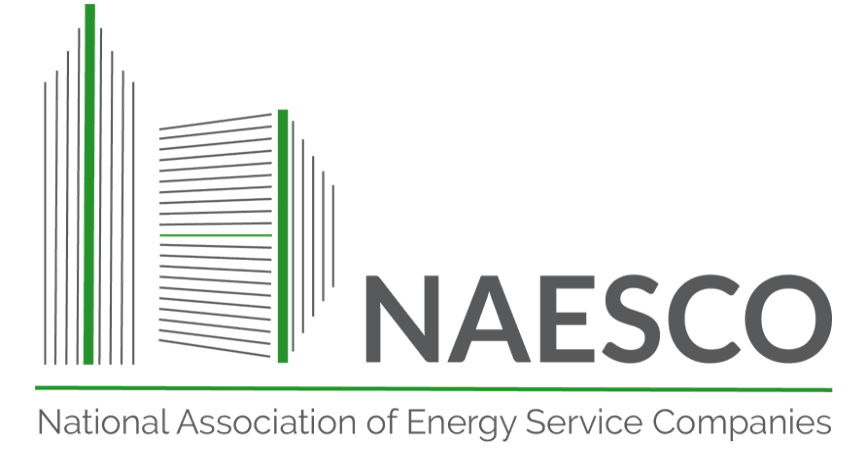Due to its versatility, compressed air is used in virtually every industry and is often considered the fourth utility alongside natural gas, electricity, and water due to its importance in many industrial processes. In fact, according to the 2014 Compressed Air Market Assessment commissioned by the U.S. Department of Energy, compressed air systems account for nearly 10% of an industrial facility’s energy usage on average with over two-thirds of manufacturers having some sort of compressed air system. For these industrial uses, compressed air may be utilized for everything from materials separation and handling to driving critical equipment, refrigeration, and powering fluid delivery systems.
Although common in industrial facilities, compressed air systems are generally one of the least efficient pieces of equipment with upwards of 80-90% of input energy lost to the heat of compression alone. Compounding this overall system inefficiency, leaks in the system, poor or inadequate maintenance, and incorrect equipment sizing all drive up energy costs and reduce the working life of compressed air systems. This means compressed air is one of the most expensive forms of energy, often times accounting for hundreds of thousands of dollars wasted annually for larger manufacturers.
Fortunately, a host of efficiency and controls improvements exist to identify and correct these inefficiencies, generating significant savings for manufacturers who in many cases cannot afford costly capital improvements or the loss of production resulting from equipment failure. Minimizing pressure drops in the system and right-sizing equipment for individual processes are both common solutions for reducing energy demand in compressed air systems though significant savings can also be achieved simply by addressing leaks, which in some instances have been found to lose up to 30% of compressed air.
However, in order to truly maximize savings, achieving system-wide efficiency and gaining increased visibility into the entire compressed air systems is paramount as many efficiency opportunities arise in unexpected places. For instance, you should certainly never settle for a cheap or low-quality compressor to start, but many facilities continue to operate with compressed air systems that are sized too large, or they utilize this equipment in inappropriate ways, in both cases driving up energy costs unnecessarily with artificial demand.
Common Air Compressor System Inefficiencies
Lack of Integrated System Control: Matching the controls of the supply side of compressed air capacity to the demand or compressed air consumption requirements is essential in maintaining an efficient compressed air system. Individual compressors are designed to deliver a particular volume of air in a specified range of pressure, and depending on the air flow range, delivers that air at varying efficiencies. Having the metering in place and the controls strategies to stage the compressors in the most efficient manner based on end-use demand is critical in having an efficient system.
Insufficient Compressed Air Storage Capacity: Sufficient air storage provided by receiver tanks eases the overall curve of air pressure delivery by allowing the air compressors to supplement the system when needed. Not having enough storage will cause unnecessary compressor cycling and can adversely impact the efficiency of the system.
Air Leaks: Air leaks cause a myriad of problems for air compression systems, most apparent being a loss of as much as a quarter of the compressor’s total output. Unnecessary cycling of the compressor and inadequate maintenance can also contribute to increased costs and decreased operational life. Control and shut-off valves, open condensate traps, pipe joints, and couplings are all common areas for compressed air leaks. It is worth noting overall system efficiency should always be reevaluated following any leak detection and repair.
Unclean Air: Many industrial applications that utilize compressed air require the air to be filtered and sent through a dryer. If you are using an oil-flooded screw compressor, for instance, oil injected into the rotors to absorb the heat of compression will later need to be filtered out before the compressed air is sent to the dryer. Although the oil helps to seal the gaps between the rotor and the housing, an improperly sized sump or oil separator can result in problems recirculating the oil and dirty the outgoing air to undesired levels. Too much moisture in the outflow and a system can malfunction due to rust, corrosion, and an increase in pressure drops in the line. Bottom line: moisture is damaging, particularly for solenoid valves and pneumatic systems.
Lack of Maintenance/Knowledge: It’s inevitable that compressed air systems will require their share of maintenance, but oftentimes plant operators and other facility staff aren’t aware of issues until it’s too late, and expensive equipment replacement remains the only option. Preventative maintenance and regular system checkups are key to ensuring the smooth and efficient operation of your air compression system. It’s good practice to keep a regular maintenance schedule for your air compressor system that includes filter replacements, leak detection and diagnostics, and other routine checks.
Insufficient or Improperly-sized Piping: To ensure the desired air velocity and pressure in a compressed air system, piping needs to be sized appropriately to match capacity. Having lots of sharp turns or bends in a system or inadequate piping can cause unwanted wear and tear by creating additional heat from friction in the compressed air flow.
Unsteady and Fluctuating Pressures: Stable pressure levels mean a more efficient compressed air system, but flow rates and pressures are often hard to measure due to production environments. Excess pressure or operating above capacity can be damaging to any system, not to mention the cause of significant expense for plant operators. Minimizing or reducing pressure drops caused by improper pipe sizing, dirty filters, or excess moisture in the system, for instance, will result in significant and immediate efficiency gains for air compressors.
Inappropriate Use: Compressed air is often chosen for applications in which other energy sources are more cost-effective. Examples are cabinet cooling, vacuum generation using the venturi-effect, and parts cleaning and debris removal. Facility staff should always consider more cost-effective forms of power before considering compressed air.
The Importance of System EnVision
Compressing air is a naturally inefficient process, but that doesn’t mean your bottom line should suffer because compressed air systems are integral to your production process. The path to energy savings and improved efficiency begins with insight—into processes, equipment, and people. Diagnosing and correcting air leaks in a compressed air system, for instance, is a straightforward and simple process in most cases but it is just one step of many to ensure maximum system efficiency and reliability on the production side.
For example, to achieve greater insight into industrial compressed air systems, Veregy has developed a comprehensive solution, EnVision, to provide system visibility that did not previously exist. Plant operators can now intelligently control and manage their air compressors for maximum efficiency by utilizing real-time production information. By incorporating and interfacing directly with real-time production data, we are able to drive savings significantly higher thanks to a sophisticated control system design that optimizes for pressure, flow, AND plant usage parameters.
Our engineers use a turnkey approach that includes the design, management, commissioning, validation, and verification of your system to deliver meaningful results. Our control system solution utilizes popular PLC platforms like those made by Allen Bradley, Siemens, and GE, so we’re able to directly integrate our compressed air solutions into your existing plant floor networks. This allows you to leverage your investment in existing control technologies, saving time and money.
By adding additional metering and adding total flow calculations used for sequence selection, Veregy’s strategy includes sequencing the compressors intelligently based on demand and pressure. The sequencing intelligence will start/stop and load/unload compressors as necessary and effectively utilize the variable speed compressors to optimize the efficiency of the system.
By optimizing these systems for pressure and flow rate, we help manage peak load demand and ensure the safety and longevity of your equipment. This also helps ensure the minimum end of line pressures required for the plant’s production to run smoothly. To further improve the smart compressor controls system, we’ve also added a metric for standard cubic feet per minute per kilowatt (SCFM/kW) to benchmark as an indicator of any efficiency drops within the system. These drops might occur when a large compressor is selected and running unloaded for any length of time. In such an event, we would flag this condition and attempt to select an even more efficient combination of compressors, further reducing energy costs for the system.
By minimizing these fluctuations, Veregy’s compressed air solution ensures reliability on the production side and bottom-line savings. Contact our engineers to discover opportunities for saving energy and maximizing the performance of your compressed air system.







